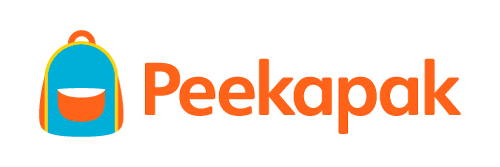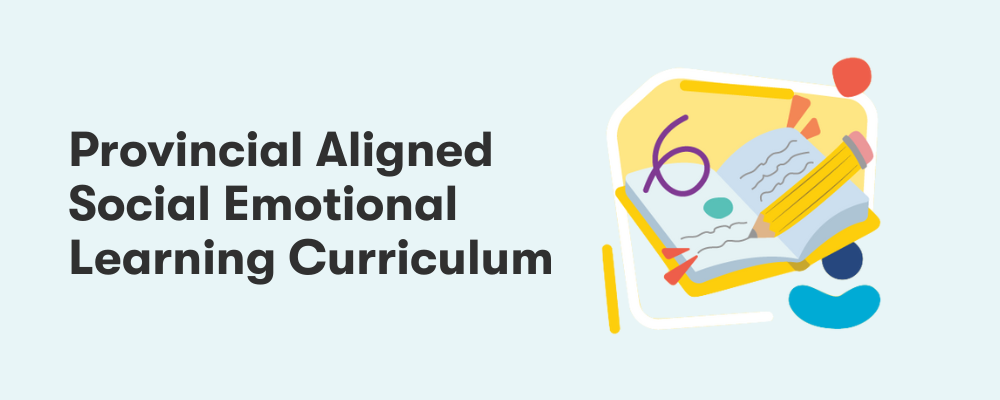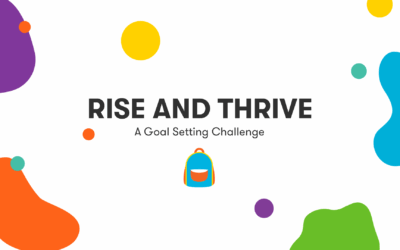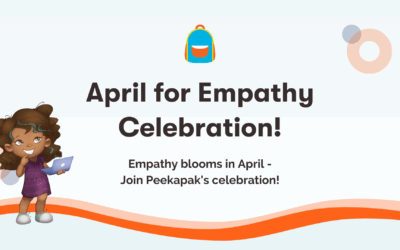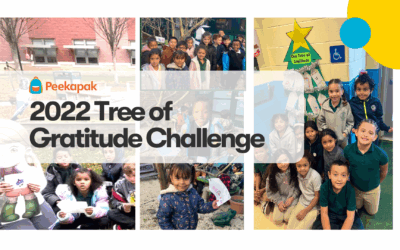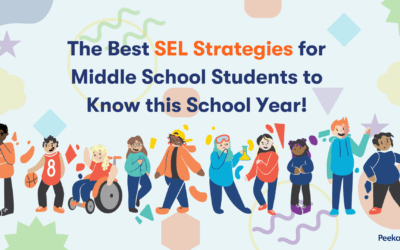“Curriculum should help children make deeper and fuller understanding of their own experience,” as said by Lilian Katz, professor of early childhood education at University of Illinois. Curriculum is the basis for all things taught in our schools and so, it is crucial that all programs, specifically SEL programs used by schools and districts aid the curriculum and not take away from it. Peekapak prides itself on providing educators with an Ontario curriculum aligned social emotional learning program for PK-8.
Interested in how Peekapak can be used in your Ontario classroom? Read further to find out or download our alignment to Ontario Learning Expectations Document here.
What is Peekapak Social Emotional Learning?
Peekapak is committed to helping children become successful, compassionate, caring, and empathetic citizens of the world! How? By teaching children important social-emotional learning (SEL) skills so that topics like Self-Regulation, Kindness, Honesty and more become not just something they hear about, but a part of who they are.
We strive to accomplish this by creating a company and content that makes SEL fun, easy and seamless for teachers, parents and especially children, so that kids learn without even realizing it. Peekapak’s learning platform can be implemented in person, online or in hybrid teaching models, providing flexible solutions for all school districts. Peekapak’s SEL program is cross-curricular and aligns with many aspects of the Ontario curriculum.
How Peekapak aligns with Ontario Curriculum…
Let’s start with the background information. Kids ages 5-14 in Ontario account for 1,556,568 of the province’s population. As of the 2019-20 school year, learning about mental health in Ontario schools takes place through a newly enhanced elementary Health and Physical Education curriculum (HPE). The HPE is integrated for elementary and middle school students including kindergarten, and as a part of students’ everyday experience at school.
The enhanced HPE curriculum takes a comprehensive approach to learning about mental health, with important new aspects that include:
- The development of Social-Emotional Learning skills across the curriculum
- Knowledge and skills related to mental health
- More opportunities to understand the connection between physical and mental health
Health & Physical Education (HPE)
Social-Emotional Learning Skills
A1. Apply to the best of their ability, a range of social-emotional learning skills as they acquire knowledge and skills in connection with the expectations in the Active Living, Movement Competence, and Healthy Living strands for this grade
- A1.1 Apply skills that help them identify and manage emotions as they participate in learning experiences in health and physical education, in order to improve their ability to express their own feelings and understand and respond to the feelings of others.
- A1.3 Apply skills that help them develop habits of mind that support positive motivation and perseverance as they participate in learning experiences in health and physical education, in order to promote a sense of optimism and hope
- A1.4 Apply skills that help them build relationships, develop empathy, and communicate with others as they participate in learning experiences in health and physical education, in order to support healthy relationships, a sense of belonging, and respect for diversity
- A1.5 Apply skills that help them develop self-awareness and self-confidence as they participate in learning experiences in health and physical education, in order to support the development of a sense of identity and a sense of belonging
How Peekapak Aligns to Ontario HPE Curriculum
Peekapak’s PK-8 social emotional learning programs perfectly align to Ontario HPE Curriculum, through self reflection, belonging, peer influence and more. Read below for specific Peekapak Ontario Curriculum correlations.
- A1.1
- K-5: Taught in the Self-Regulation unit with the story Classroom Chaos. As well as the Empathy unit with the story New Student.
- 6-8: Taught in the Stress & Regulation unit, as well as Empathy & Conflict Resolution unit.
- A1.3
- K-5: Perseverance is a unit taught with the aid of our original SEL story called Sounds of Music and the Optimism unit is taught with the Mysterious Box story.
- 6-8: The Stress Management & Regulation unit focuses on self-management and allows students to learn how to manage and respond to stresses in a positive way.
- A1.4
- K-5: Students learn through the Respect and Friendship units with the help of our unique stories about relationships, making friends, communication and having respect for others.
- 6-8: The units of Belonging & Peer Influence, as well as Empathy & Conflict Resolution are used to teach relationship skills and social awareness aligning with positive relationship building and understanding differences.
- A1.5
- K-5: Students can learn self awareness and self confidence in the Self-Regulation unit. Students learn how to be self-aware and how to respond to different stimuli.
- 6-8: Our unit on Identity & Self-Awareness. This unit focuses on understanding who you are, why you are that way, what you can control and who you want to be. The unit on Belonging & Peer Influence allows students to get a sense on how to fit in and feel like they belong within their communities.
Healthy Living
D1. demonstrate an understanding of factors that contribute to healthy development
- D1.4 identify the characteristics of healthy relationships (e.g., accepting and respecting differences, avoiding assumptions, being inclusive, communicating openly, establishing and respecting personal boundaries, listening, showing mutual respect and caring, being honest) and describe ways of responding to bullying and other challenges (e.g., exclusion, discrimination, peer pressure, abuse) and of communicating consent in their interactions with others
- D1.5 demonstrate an understanding that mental health is a part of overall health and reflect on the things they can do to appreciate and take care of their body and mind
- D1.6 demonstrate an understanding of how a person’s body and brain respond to challenging or uncomfortable situations (e.g., they may feel tired, easily overwhelmed, confused, or overstimulated; they may want to cry or they may have very intense feelings; they may get a headache or feel hot), and describe what they can do to feel better at those times
D2. demonstrate the ability to apply health knowledge and social-emotional learning skills to make reasoned decisions and take appropriate actions relating to their personal health and well-being
- D2.3 demonstrate the ability to recognize caring behaviours (e.g., listening with respect, being helpful, respecting boundaries) and behaviours that can be harmful to physical and mental health (e.g., ignoring or excluding others; bullying; manipulative behaviours; sexually exploitative or abusive behaviours, including inappropriate touching; verbal, emotional, or physical abuse), and describe the feelings associated with each, as well as appropriate ways of responding, demonstrating an understanding of the importance of consent
- D2.5 demonstrate an understanding of how choices they make every day can have a positive impact on their mental health
D3: demonstrate the ability to make connections that relate to health and well-being – how their choices and behaviors affect both themselves and others, and how factors in the world around them affect their own and others’ health and well-being.
- D3.1 describe how to relate positively to family members, caregivers, and others and describe behaviors that can be harmful in relating to others
- D3.3 demonstrate an understanding that a person’s thoughts, emotions, and actions can affect mental health
- D3.4 reflect on external factors, including environmental factors, that may contribute to experiencing a range of strong feelings, including uncomfortable feelings such as worry (e.g., transitions, such as starting a new grade, moving, or family separation; excessive heat, cold, or noise; unexpected changes in routine; significant losses, such as the death of a family member or pet) and identify ways to help them manage these feelings
How We Align
The connection between you living a healthy life and SEL are closely linked. Healthy relationships, decision making and self-regulation are embedded in Peekapak, with full units dedicated to teaching these skills.
Our Pre-K to 5 units use unique SEL related stories with consistent characters to teach these crucial lessons. The consistent characters throughout the stories allows students to connect better to the stories, as well see an example in action of characters they feel like they know when teaching the unit skills.
Our middle school program (grades 6-8) uses real-life human interest stories that tackle situations that children aged 10-14 may be struggling with. This relatable content allows students to see a bit of themselves in someone else, and not feel so alone in their current situations. Students are also able to apply the coping strategies and skills learnt and used by the individual in the story in their own lives.
Language
Oral Communication
2.2 demonstrate an understanding of appropriate speaking behavior in a variety of situations, including paired sharing and small- and large-group discussions
2.3 communicate ideas, opinions, and information orally in a clear, coherent manner using simple but appropriate organizational patterns
How We Meet Ontario’s Oral Communication Curriculum
Within Peekapak, all units have at least one lesson plan involving class and/or small group discussion. This allows students to practice appropriate speaking behavior and adapt how they talk depending on the number of people included in the discussion. As well, students are able to practice clear and concise communication of their thoughts and ideas in an oral manner.
Reading
- 1.3 identify a variety of reading comprehension strategies and use them appropriately before, during, and after reading to understand texts
- 1.4 demonstrate understanding of a variety of texts by summarizing important ideas and citing supporting details
- 1.5 make inferences about texts using stated and implied ideas from the texts as evidence
- 1.6 extend understanding of texts by connecting the ideas in them to their own knowledge, experience, and insights, to other familiar texts, and to the world around them
- 1.7 analyze texts and explain how specific elements in them contribute to meaning
- 1.8 express opinions about the ideas and information in texts and cite evidence from the text to support their opinions
- 1.9 identify the point of view presented in a text, citing supporting evidence from the text, and suggest some possible alternative perspectives
- 2.4 identify various elements of style – including alliteration, descriptive adjectives and adverbs, and sentences of different types, lengths, and structures – and explain how they help communicate meaning
- 3.1 automatically read and understand high-frequency words, most regularly used words, and words of personal interest or significance in a variety of reading contexts
- 3.2 predict the meaning of and rapidly solve unfamiliar words using different types of cues, including semantic, syntactic, graphophonic
- 3.3 read appropriate texts at a sufficient rate and with sufficient expression to convey the sense of the text readily to the reader and an audience
How we meet this
At Peekapak, our unique and original stories are a great tool to cross off the reading curriculum off that yearly checklist. All of our PreK-5 stories are available in four reading levels to choose from that align with your students’ reading levels. This includes Fountas & Pinnell, Reading Recovery, Developmental Reading Assessment (DRA) and PM Benchmark. Our stories also have a read aloud option for students still learning how to read! Our units allow students to make connections with the stories by setting up discussions as part of the lesson to identify the skill being taught or connect the story to their lives.
Our middle school reading consists of real-life human interest stories that supplement the units. These stories allow students to see real examples of the skills being taught. Within each unit, lessons are designed to cover connections (text-to-self, text-to-text, text-to-world), class discussions, reflection, comprehension questions and more.
Therefore Peekapak is a great cross-curricular tool that aligns with the Ontario curriculum.
As you can see, Peeakapak is the perfect Ontario curriculum aligned social emotional learning resource. Are you ready to bring a turnkey, engaging SEL resource to your school or district? Dig a little deeper, check out our website and see all the features we have to offer and try out our 14-day free trial.
